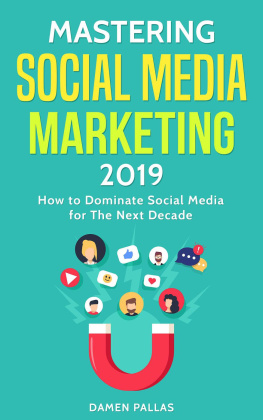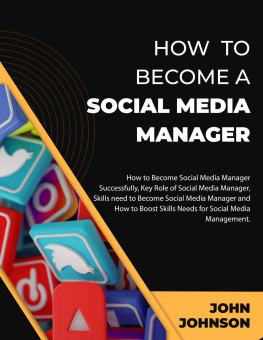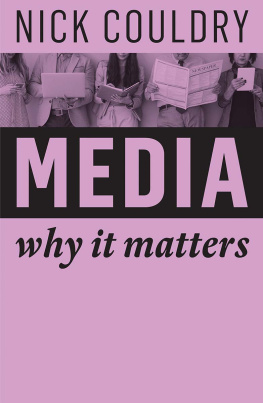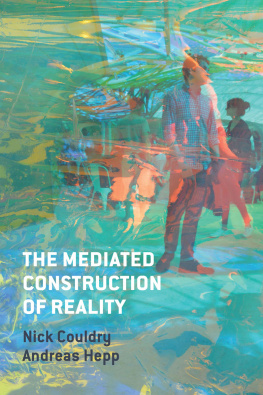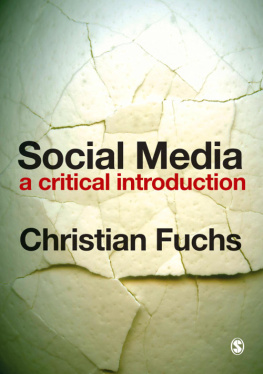SAGE Publications Ltd
1 Olivers Yard
55 City Road
London EC1Y 1SP
SAGE Publications Inc.
2455 Teller Road
Thousand Oaks, California 91320
SAGE Publications India Pvt Ltd
B 1/I 1 Mohan Cooperative Industrial Area
Mathura Road
New Delhi 110 044
SAGE Publications Asia-Pacific Pte Ltd
3 Church Street
#10-04 Samsung Hub
Singapore 049483
Nicholas Carah 2021
Apart from any fair dealing for the purposes of research, private study, or criticism or review, as permitted under the Copyright, Designs and Patents Act, 1988, this publication may not be reproduced, stored or transmitted in any form, or by any means, without the prior permission in writing of the publisher, or in the case of reprographic reproduction, in accordance with the terms of licences issued by the Copyright Licensing Agency. Enquiries concerning reproduction outside those terms should be sent to the publisher.
Library of Congress Control Number: 2020948100
British Library Cataloguing in Publication data
A catalogue record for this book is available from the British Library
ISBN 978-1-5297-0796-0
ISBN 978-1-5297-0795-3 (pbk)
Editor: Michael Ainsley
Assistant editor: Charlotte Bush
Assistant editor, digital: Sunita Patel
Production editor: Rachel Burrows
Copyeditor: Sarah Bury
Proofreader: Leigh C. Smithson
Indexer: David Rudeforth
Marketing manager: Abigail Sparks
Cover design: Lisa Harper-Wells
Typeset by: C&M Digitals (P) Ltd, Chennai, India
Printed in the UK
At SAGE we take sustainability seriously. Most of our products are printed in the UK using responsibly sourced papers and boards. When we print overseas we ensure sustainable papers are used as measured by the PREPS grading system. We undertake an annual audit to monitor our sustainability.
About the Author
Nicholas Carahis an Associate Professor and Deputy Head of School in the School of Communication and Arts at The University of Queensland. Nicholas is a UQ Teaching Fellow (20182019) and leader in the development of student partnership and blended learning at the university. He has been awarded the Faculty of Humanities and Social Sciences Award for Teaching Excellence (2019) and The University of Queensland Award for Teaching Excellence (2020).
His research examines the algorithmic, promotional and participatory cultures of digital media platforms. He is currently a Chief Investigator on an Australian Research Council Discovery Project (20202022) Using machine vision to explore Instagrams everyday promotional cultures and Linkage Project (20212023) Young Australians and the promotion of alcohol and nightlife on social media. He has worked with the Foundation for Alcohol Research and Education and VicHealth to track below-the-line marketing on social media platforms and with the social change start-up Hello Sunday Morning to evaluate their use of digital media to change drinking cultures.
Nicholas research has been published in
Media, Culture & Society, Social Media & Society, New Media & Society, Television & New Media, Convergence, Consumption, Markets & Culture and
Mobile Media & Communication. His 2014 article Brand value was awarded best paper in
Consumption, Markets & Culture. He is the author of
Brand Machines, Sensory Media and Calculative Culture (2016),
Media and Society: Production, Content and Participation (2015) and
Pop Brands: Branding, Popular Music and Young People (2010). He is the co-editor of
Digital Intimate Publics and Social Media (2018).
Acknowledgements
This book is the product of many collegial relationships formed around a decade of teaching Media & Society. Many of the arguments find their genesis in Eric Louws (2001) The Media and Cultural Production, which we used as the starting point for our co-authored first edition of Media and Society (2015). Eric generously agreed to let me take the work forward into this next edition. I acknowledge his contributions to this work particularly arguments about meaning, power and hegemony. I thank him for the many conversations about media, history and politics that shaped my thinking as I worked on this edition.
I have been very fortunate at The University of Queensland to work with colleagues teaching Media & Society over the past decade. Many of the ideas and arguments were refined teaching collaboratively in our seminars. I acknowledge the contributions made to the course over several years by Elena Block, Deborah Thomas, Kate Warner, Samantha Lindop, Lujain Shafeeq, Regan Neal and Adam Dodd. Thanks to Elena Block for her suggestions around current arguments about media and hegemony. Thanks also to Mallory Peak for her collaboration in the writing of early versions of audio scripts about key concepts in the course.
As a 2018 Teaching Fellow at The University of Queensland I had the opportunity to work with several groups of student partners to develop the course. They played a significant role, contributing ideas and ways of thinking about our lived experience with media. Thanks to Shi Pui Ng, Heather Martin, Kirsten Slemint, Rachel Western, Bingxi Huang, Nicola Cook, Maria-Gemma Brown, Sami Heinonen-Barnes, Lucinda Jones, Emma Halliday, Odette Miller, Meg Thomas and Lillian Rangiah.
I was also fortunate to work with a team of learning designers and media producers at UQx to develop a blended version of this course, including animations, video, audio, and interactive activities. Much of that work informed aspects of the writing in this text. Im grateful to UQs Institute for Teaching and Leaning Innovation for permission to draw on that work in this book. Thanks in particular to Linda MacDonald, Karen Sheppard, Matt Petersen and Dan Greenup, along with the wider team of learning designers and media producers.
Two colleagues in particular have made significant contributions to particular aspects of the book. Elliott Logan worked as a researcher and writer on the blended version of the Media & Society course. Some of the work that we co-authored and produced as video informs the discussion of semiotics and encoding/decoding in the book. Im grateful to Elliott for his generosity in allowing me to use this material. Natalie Collie has been a wonderful intellectual companion as we have designed and experimented with this course over many years. Her attention to narrative and design in the way we craft learning activities and assessments is exceptional and inspiring. Im grateful for Natalies generosity in drawing on some of the activities and materials we prepared in teaching collaboratively, particularly our exercises around analysing media platforms in the book.


